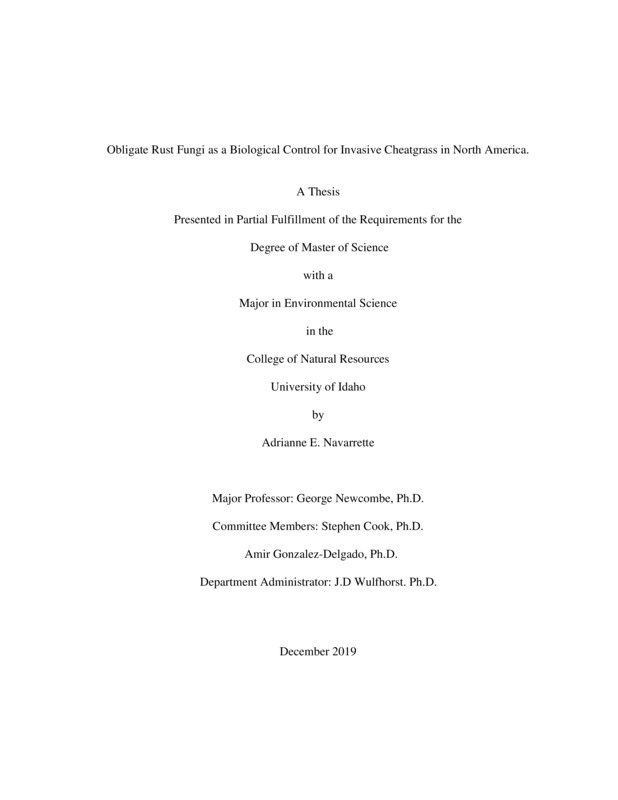Obligate Rust Fungi as a Biological Control for Invasive Cheatgrass in North America.
Navarrette, Adrianne Elice. (2019-07). Obligate Rust Fungi as a Biological Control for Invasive Cheatgrass in North America.. Theses and Dissertations Collection, University of Idaho Library Digital Collections. https://www.lib.uidaho.edu/digital/etd/items/navarrette_idaho_0089n_11691.html
- Title:
- Obligate Rust Fungi as a Biological Control for Invasive Cheatgrass in North America.
- Author:
- Navarrette, Adrianne Elice
- ORCID:
- 0000-0001-5945-3635
- Date:
- 2019-07
- Keywords:
- biological control Bromus tectorum cheatgrass invasive species Puccinia madritensis rust fungi
- Program:
- Environmental Science
- Subject Category:
- Environmental science
- Abstract:
-
In the Intermountain West of the United States, cheatgrass (Bromus tectorum L.) is a widespread invader. Its relative abundance is highest among all plants in many areas of the region. As a winter annual, it dries after seed set in late spring to become a fine, easily ignited fuel that sparks destructive fires. Many possible control measures for cheatgrass have been researched, but classical biological control with rust fungi has never been attempted; it would entail the deliberate introduction from the native range of obligate, and narrowly host-specific parasites in the genus Puccinia. For it to be worth attempting, cheatgrass would have to be in a state of release from rust pathogens in its invaded range in western North America, and rust in the native, Eurasian range would have to be virulent and aggressive on western North American genotypes of cheatgrass.
The first chapter details the history of cheatgrass invasion in North America and the consequences to local ecosystems. A records review also shows, at least superficially, that USDA records of fungi on plants do not show release: records of rust fungi are as common on B. tectorum in western North America as they are in its Eurasian native range. However, in surveys in northern Idaho from 1999 to 2018 inclusive, rust was found on cheatgrass only in 2017, and then only minimally in terms of incidence and severity. Surveys in New Mexico in three years (2015, 2018, 2019) revealed no rust. Our surveys contradicted the records-based view and portray cheatgrass populations to be in a state of release.
Secondly, Idaho and Montana genotypes of cheatgrass developed severe rust in Israel. A study to determine the host specificity of P. madritensis to the Genea section of the genus Bromus is discussed. These studies will aim to indicate if native-range rust fungi should be considered for deliberate introduction into the invaded range of cheatgrass.
- Description:
- masters, M.S., Environmental Science -- University of Idaho - College of Graduate Studies, 2019-07
- Major Professor:
- Newcombe, George
- Committee:
- Cook, Stephen; Gonzalez-Delgado, Amir
- Defense Date:
- 2019-07
- Identifier:
- Navarrette_idaho_0089N_11691
- Type:
- Text
- Format Original:
- Format:
- application/pdf
- Rights:
- In Copyright - Educational Use Permitted. For more information, please contact University of Idaho Library Special Collections and Archives Department at libspec@uidaho.edu.
- Standardized Rights:
- http://rightsstatements.org/vocab/InC-EDU/1.0/

